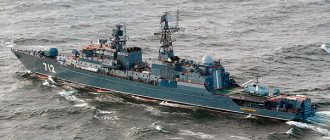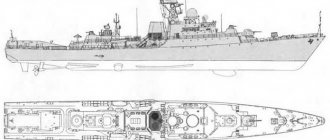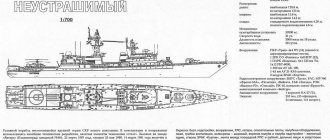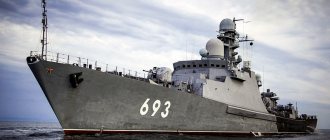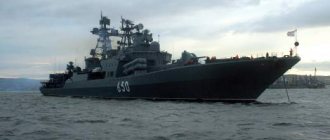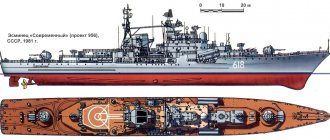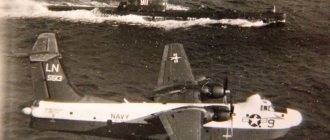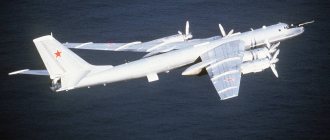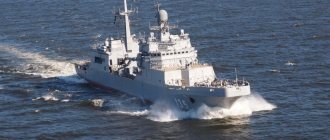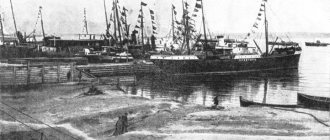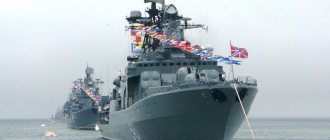For the Russian Navy, the task of defending the coastal maritime zone was, is and remains one of the most pressing tasks. This is due to the large length of the state’s maritime borders and the presence in the coastal maritime zone of a large number of strategically important military and economic facilities. A similar strategy was followed in the Soviet Union, where patrol officers performed the function of protecting sea borders. The picture has not changed today. Today, obsolete combat vessels have been replaced by new and advanced combat vessels - Project 20380 ships.
Combat necessity or tribute to tradition
Patrol ships in the Russian fleet are not a new phenomenon. Russian sailors became acquainted with ships of this class during the First World War. These relatively small military vessels have become universal combat units, performing a huge amount of combat work. Abroad, such ships were classified as frigates and corvettes. The Russian Navy went its own way, creating a separate class of warships - patrol ships.
The appearance of these ships in the fleet was caused by an urgent need. Destroyers could also perform the functions of protecting the coast and sea raids, guarding convoys and countering small forces of the enemy fleet, but these ships were few in number. Building new destroyers in large numbers was an expensive proposition. It was considered that it would be more profitable to use similar vessels of a smaller displacement to perform the assigned tasks. Patrol ships should not be compared with destroyers in terms of combat and seaworthiness - these are completely different warships in terms of the nature of their use. Such ships must be universal and built en masse.
The economic factor also played a huge role. The construction of one patrol ship, frigate or corvette cost the treasury two or three times less than the construction of one destroyer. The Soviet Union was able to appreciate these advantages. In the 20s and 30s, in difficult economic conditions, the construction of patrol ships became the only opportunity for the USSR to increase the combat effectiveness of its fleet. In pre-war times, during the war years, patrol ships became the most massive combat vessels of the Soviet Navy. A similar principle of naval recruitment was followed in the USSR in the post-war period. The fleet was equipped with more powerful and advanced ships, due to which the class of patrol ships received a new development.
Unlike the first ships of this class, the Soviet patrol ships (SKR) became an order of magnitude stronger and more powerful. The Soviet Union is building ships that are not inferior to destroyers in terms of firepower and technical equipment. Abroad, Soviet patrol ships have long been classified as frigates, considering them full-fledged combat vessels. In the USSR they were used to building a lot and powerfully. Accordingly, the patrols became larger in size and received powerful weapons. This trend continued until the last days of the Soviet Union. It was planned to build project 11540 patrol ships for the fleet - large ocean-going warships. There was no need to say that the fleet needs TFR for the protection and defense of the coastal maritime zone. This niche in the Soviet Navy remained unfilled.
In Russia, which inherited a huge navy from the Soviet Union, it was necessary to solve the problem of creating ships in the near sea zone from scratch. Initially, Project 12441 ships were supposed to solve the problem, but it didn’t work out with Novik, the lead ship of the project. The project was rejected. It was decided to begin construction of the TFR in the form and in the version in which these ships should have been originally. In such conditions, Project 22380 was born, which provided for the construction of a small patrol ship to protect the near sea zone.
Serial, but different in their uniqueness, corvettes
As often happens with all new projects, the ships encountered a lot of criticism along their paths. Basically, the insufficient cruising range was criticized. However, this is still due to the fact that previously the class of corvettes itself was not in service with the Russian Navy. Skeptics should understand that the very list of tasks facing the Navy has changed significantly. Today, having dozens of corvettes at your disposal is much more important than having a small number of ocean-going destroyers.
Discussions often arose over the ship's weapons; security and survivability were raised in doubt. However, it is also difficult to pay attention to these qualities if you do not have at least a general idea of the tactical schemes that characterize the corvette classes themselves. Although the project itself is promising, it is not yet perfect.
In the first few years of service and combat activity on the Steregushchy, problems with the main power plant appeared twice. These emergency situations became the pretext for comparing the “diesel-diesel” with the gas turbine engine, which is more reliable and lighter, but incomparably more expensive.
Also, the corvette “Boiky” was unable to immediately enter service when problems were discovered in the 100-millimeter gun mount. “Universal” refused to operate under normal conditions, and not only on Project 20380 itself. The same fate befell the Indian frigate from the Russian manufacturer.
Be that as it may, the main advantage of all corvette-type ships is their flexibility. Diesel installations have the potential for modifications, artillery installations can be replaced, but the ships themselves will not remain on the stocks and will not turn into “unfinished construction”. According to the corvette developers, none of the ships will repeat the previous one. Actually, because of the flexibility, availability, serial production and, in the future, mass production of Russian-made corvettes, Project 20380 expects great success, as do all Russian Navy forces.
The first steps towards building a new watchtower
In the difficult 90s, the main task of the command of the Russian Navy was to preserve the combat effectiveness of the naval personnel inherited from the Soviet navy. The need to build new ships was acutely felt, but economic difficulties and lack of funding did not allow the construction of new warships to begin on a large scale. Due to the fact that it was considered inappropriate to implement Project 12441, the country's top naval leadership set a task for domestic shipbuilders: to create a small patrol ship that could replace the Soviet-built patrol ships being withdrawn from the fleet.
This task was traditionally entrusted to the Almaz Central Marine Design Bureau, one of the country's leading domestic design bureaus. The technical specifications for the future project indicated the main technical parameters of the new ship. This was supposed to be, in accordance with the Western classification, a multi-purpose corvette of Project 20380. In simple terms, it was necessary to create a simple and cheap surface ship of the 2nd rank, designed to perform combat missions in coastal sea areas.
The design began in 1997. The final form of the project was formed by 2001. It was decided to entrust the construction of new ships to the St. Petersburg “Northern Shipyard”. This shipbuilding enterprise was supposed to ensure the construction of ships for the needs of the Baltic Fleet. If the project was successfully implemented, it was planned over time to begin building new corvettes in the Far East, which would be equipped with the Pacific Fleet.
In accordance with the project, the new patrol aircraft was supposed to perform the following combat missions:
- the main area of operation of the ship is coastal waters and the economic maritime zone;
- the main function of the ships was to fight surface ships and submarine forces of the potential enemy fleet;
- patrolling in the area of responsibility, protection of coastal sea communications, blockade of coastal infrastructure.
In general, there was nothing new in the purpose of the new combat ships. All of the listed goals corresponded to this class of ships, which would have to tightly close the coastal sea flank from encroachment.
The laying of the lead ship of the Steregushchy corvette project took place in December 2001. In total, the Navy command plans to receive 7 Project 20380 ships from shipbuilders as part of the first order. Two years later, the laying of the next ship of this type, the Soobrazitelny corvette, took place. In 2005, the laying of the third ship, named “Boikiy,” took place. By this time, the lead ship had been launched. The Steregushchy corvette still had to go through a long cycle of factory completion, equipping with navigation and weapons, acceptance and commissioning.
The construction of the remaining ships in accordance with the State order for the Baltic Fleet at the Severnaya Verf continues today. The first four ships have been commissioned and are part of the Baltic Fleet. Due to the success of the ship design, the project was continued. In 2015, the keel of two more ships for Baltic sailors took place; the corvette “Retivy” and a ship of the same class “Strogiy” are planned to be delivered to the fleet by 2022.
In the summer of 2006, the laying of the first ship of Project 20380 took place at the Amur Shipyard in Komsomolsk on the Amur. Today, this perfect and modern ship called “Perfect” is already included in the Pacific Fleet. The subsequent implementation of Project 20380 is focused on the construction of combat ships for the needs of the Pacific Fleet. The second ship built at the ASZ in accordance with the technical re-equipment program of the Pacific Fleet, the Gromky corvette is expected to be transferred to the fleet in 2022. Today, the ship is fine-tuning and debugging the ship’s main systems, including the control and electrical systems.
At the moment, the capacity of the shipbuilding plant in Komsomolsk-on-Amur is fully loaded. Following the “Gromky”, the construction of two more corvettes of the same type is underway: the ships “Hero of the Russian Federation Aldar Tsydenzhapov” and “Rezky”, on which work has begun on the formation of the hull. The vessels should be transferred to the Pacific Fleet in 2020-21.
Strength lies in versatility: Russian officers appreciated the Gromky corvette
Project 20380 corvettes are developed by the Almaz Central Marine Design Bureau. The length of ships of this type is 104.5 meters, width - 13, total displacement - 2.2 thousand tons. The maximum speed is up to 27 knots, it can travel up to 4000 nautical miles, the crew is 100 people.
Domestic corvettes of this type are built at two enterprises in different parts of the country. The first - shipbuilding (St. Petersburg) - can already boast of the ships “Boikiy”, “Steregushchiy”, “Soobrazitelny” and “Stoikiy”, which are serving in the Baltic Sea. The second enterprise where modern “watchdogs” are created is located in the Far East - in Komsomolsk-on-Amur. Here, serial production is carried out by PJSC Amur Shipyard. Unlike their St. Petersburg colleagues, the achievements here are still more modest: at the moment, only one corvette has been built, on which the shipbuilders have been working for more than 11 years. The combat unit, which has been assigned to the Pacific Fleet since 2022, is called “Perfect”. The ship has been in service for a year now, performing combat duty, as well as taking part in military exercises and international military games “Army”. However, the production of corvettes in the Far East did not stop with the “Perfect” - the next one, called “Loud”, is next in line.
“Gromky” was laid down in 2012 in Komsomolsk-on-Amur (Khabarovsk Territory), and unlike its “big brother” it was built almost twice as fast. Five years later, in July 2017, the ship left the slipway, and in 2018 it was sent for completion to Vladivostok in the Zeya floating transport and launching dock (TSTDD-5). The transfer of a warship from the Amur River to the Tatar Strait, and then to the capital of Primorye, was carried out in this way for the first time in several decades and lasted more than 20 days.
— This transition from the Khabarovsk Territory to Vladivostok was only beneficial, since it allowed us to begin mooring tests. The ship is seaborne, and therefore it must be tested at sea, and not on the Amur River. We, as representatives of the plant, are fully aware of the responsibility before us in connection with the construction of a new warship. We must deliver it by the end of the year,” says Yuriy Lysenkov, chief builder of the Amur Shipyard.
Already in Vladivostok, at the delivery base of PJSC ASZ in Zolotoy Rog Bay, the new ship was prepared for control checks and painted - the number “335” appeared on board. And on October 28, the corvette “Gromky” set off on its first sea voyage under its own power, passing under the Golden and Russian bridges towards Peter the Great Bay. According to the head of the commissioning base of Amur Shipyard PJSC Vyacheslav Atyukov, sea trials are a mandatory measure to assess the seaworthiness of a ship, as well as check its suitability for operation. Thus, during an important technological phase, factory workers, together with military personnel, will observe how navigation equipment, as well as power plants, operate. In addition, specialists will check the compliance of seaworthiness, driving and maneuverability. All equipment and systems must operate reliably and in accordance with design documentation. All these checks will last for several days in the Sea of Japan, after which a list of comments will be drawn up that must be eliminated before state tests and the ship's inclusion in the Navy.
Representatives of the Ministry of Defense must raise the St. Andrew's flag on Gromky by the end of this year. It will become the second modern ship to enter the Pacific Fleet for the first time since the collapse of the USSR. Military experts express the opinion that the new ship, like subsequent representatives of the corvettes of this series, will strengthen Russia’s defense in the near sea zone.
Veteran of the Armed Forces, ex-deputy commander of the Pacific Fleet, vice admiral of the reserve Alexander Konev, recalling the Soviet analogues of modern corvettes, cites patrol ships as an example. In his opinion, the current Project 20380 corvettes are much more effective and are multifunctional combat units:
— These are good ships, which were created by modern specialists and using new technologies. Such a corvette is equipped with a whole range of weapons against submarines, surface ships, and air targets. Therefore, their strength lies in their versatility. Taken together, the appearance of such ships will provide new opportunities for the fleet, says Reserve Vice Admiral Alexander Konev.
It should be noted that the main anti-ship weapon of the Gromky corvette is the Uran missile system. Its missiles are capable of hitting targets at a distance of up to 260 km. Of the artillery installations on the ship, there is a 100 mm A-190, as well as two six-barreled 30 mm AK-630M. The ship can be protected from air targets by the Redut anti-aircraft missile system. The Package-NK complex protects the corvette from enemy submarines. It is noteworthy that the designers tried to make modern ships of this project inconspicuous to enemy radars by using stealth technology. In addition, the ship is built in a modular version. According to engineers and military personnel, if necessary, it can be modernized in a fairly short time, replacing entire sections of the ship or weapons. For example, the Uran missiles should be replaced with more formidable weapons—Caliber cruise missiles capable of carrying a nuclear charge.
Military expert, chairman of the Council of Veterans of the Pacific Fleet, commander of the diesel submarine of Project 611, captain 1st rank in the reserve Igor Litvinenko notes that currently the function of protecting the coastal zone at the Pacific Fleet is given to small missile ships, which cannot be compared with the new corvettes entering service.
“Currently, the near sea zone is guarded by small missile boats (SMB), but each ship must carry out its functions and should not be overloaded with other tasks. Of course, MPCs do not have such powerful strike systems as the Uran, or effective anti-submarine weapons like the Package-NK. We now really need Project 20380 corvettes, and not in single quantities, but in dozens. If we compare it with the Soviet period, then the functions of corvettes were performed by patrol ships. With the advent of the 2nd rank ships of Project 1135 in the USSR Navy, one example of which was the patrol ship “Smashing”, the situation at sea changed dramatically. I once took part in one of the naval operations, and then the patrol ship “Smashing” with its anti-submarine complex, unique at that time, was the icing on the cake. But it is clear that over time their resource began to expire, and coastal protection was given to small anti-submarine ships,” says Igor Litvinenko, captain of the 1st rank of the reserve.
According to a military expert, the new ships will also make it possible to remove unusual functions from other ships of the Pacific Fleet. Including from large anti-submarine ships.
— At the Pacific Fleet, four ships in the ocean zone are now reaching their last resource. With the enormous, heroic and titanic efforts of their personnel, they carry out tasks, taking part in long-distance campaigns. I'm talking about ships such as the BOD Admiral Tributs, Admiral Vinogradov and Admiral Panteleev, as well as the destroyer Bystry. The appearance of corvettes will make it possible to remove a certain load from them, says a veteran of the Armed Forces.
As for the balance of power in the Pacific Ocean, Igor Litvinenko believes that the 20380 corvettes will not be able to change much, since the United States has always had the advantage of the surface fleet.
— We have always been inferior to the Navy of the United States of America, even during the Soviet period. Now our position and theirs are incomparable, to put it in one word. Corvettes are short-sea ships, and global change requires an ocean-going fleet. Now the task of creating such a fleet is not worth it at all. Currently, the military department sets the task of protecting coastal borders. And for this we need a reliable coastal fleet. By the way, twice already our commander of the Pacific Fleet, Admiral Sergei Avakyants, when he was congratulated on Navy Day, speaking about the modernization process, mentioned exactly this wording - the Pacific Coastal Fleet.
Considering the US advantage in the surface fleet in the Pacific Ocean, the military expert calls Russia's main strength strategic nuclear submarines. It is these that modern corvettes will have to protect in the near sea zone. The surface fleet, in the opinion of a reserve officer of the Pacific Fleet, in this region could be strengthened by Project 11356 frigates, however, according to the plans of the Ministry of Defense, in the near future they will serve only in the Black Sea Fleet
Features of Project 20380 corvettes
You shouldn’t think that Project 20380 corvettes have become something new for the Russian Navy. Taking a close look at the ships, you can see external similarities with other combat ships in service with the Russian fleet. A similar scheme is implemented today in different versions during the construction of other warships. Small missile ships of the Buyan-M type, although they have half the displacement, have the same hull contours and superstructure configuration. Project 22350 ships, built for combat service in the far sea zone, also have similar similarities. The ships differ only in size, displacement and weapons range.
It should be noted that the concept of the development of a modern Russian navy received maximum implementation in the Project 20380 corvettes. The design of the ships is thought out and worked out. The main systems of the combat vessel are automated and equipped with modern electronic digital instruments and devices.
Thanks to their successful design, the ships have excellent seaworthiness. Despite the fact that corvettes are considered coastal ships, the cruising range of these ships is 3,500 km. Comfortable conditions have been created on board the vessel for the crew, who can remain autonomously on a combat mission for up to 15 days.
All the main components and assemblies of the ship are highly technologically advanced and have a high degree of maintainability. The design of the ship allows for its future modernization. The propulsion system of the corvettes is represented by two DDA 12000 diesel engines designed by Kolomensky Machine-Building Plant OJSC. As a result of the successful layout of the ship's hull and engines, the ship with a displacement of 1,500 tons has a good speed. The twin-shaft propulsion system allows the ship to move at a maximum speed of 27 knots. Particularly worth noting is the low noise level of the operating engines, which thereby provides the ship with low visibility in the hydroacoustic range. In terms of stealth, the new Russian corvettes are a masterpiece of engineering. In addition to the fact that the ship itself has a specific superstructure configuration and hull contours, composite materials are widely used in the ship’s design.
Navigation equipment, masts and antennas can be stowed inside the superstructure. The general concept is consistent with the use of Stealth technology. The corvettes “Boikiy” and “Stoikiy” demonstrated satisfactory radar signature parameters during testing at the sea test site. This is especially important when sailing in the Baltic Sea, where coastal and aviation anti-ship weapons systems of NATO countries are present.
The armament of Project 20380 ships is universal. The first production ships that are in service with active fleets are equipped with:
- main strike weapon, the Uran anti-ship complex, equipped with 8 X-35 missiles;
- defensive anti-aircraft missile system "Kortik-M", consisting of 30-mm artillery mounts AK-630M and portable air defense systems "Igla". In the future, it is planned to equip the ships with a more advanced Redut air defense system with a firing range of 10 km;
- 100-mm artillery mount A-190, capable of hitting all types of ground and surface targets at a distance of up to 21 km;
- anti-submarine complex "Packet-NK", which includes two torpedo tubes with a caliber of 330 mm.
The Ka-27 helicopter is based on the corvettes as an auxiliary anti-submarine and search weapon. The aircraft is located on an open runway or in a closed hangar.
The navigation complex of Project 20380 corvettes is represented by the Furke-2 detection radar station. To control the missile system, it has its own target designation radar and the Monument missile fire control system. The vessel is controlled and positioned using the GLONASS-based satellite navigation system CH-3101.
To control all combat systems of the ship, there is a Sigma-20830 BIUS system and a 5P-10-02 Puma control system. The corvette's radar armament is enhanced by an electronic jamming system and other electronic warfare equipment.
Corvette "Staudy"
Corvette "Stoikiy" is the third production corvette in Project 20380, built for the Baltic Fleet. This is already a fundamentally new ship for the Russian Navy, the tactical, technical characteristics and combat properties of which are an order of magnitude superior to similar ships in its class.
The most important feature of the Corvette is that it is sharper, more multifunctional, flexible, compact, unobtrusive, with a high level of automated and integrated systems. The project provides significant potential for its further modernization. The project 20380 corvette with a displacement of more than two thousand tons, a length of one hundred meters and a width of thirteen meters reaches a speed of up to twenty-seven knots. The range of sea crossings that the ship can make has been increased to four thousand nautical miles. The ship is no longer as loud as its predecessors were.
The corvette is armed with a hundred-millimeter universal artillery system and an anti-aircraft missile and artillery system. In addition, it is armed with supersonic missiles and automatic artillery mounts. The air group of this ship, however, as in previous corvettes, included one Ka-27PL helicopter. The ship received a strict appearance that meets all modern requirements of stealth technology.
Development and design [edit]
Main article: Steregushchiy-class corvette
Steregushchiy class corvettes
" have a steel hull and a superstructure made of composite materials, with a bulbous bow and nine watertight compartments.
They have a combined bridge and command post, and provide space and weight for eight SS-N-25 missiles. Stealth technology was widely used in the construction of the ships, and 21 patents and 14 new computer programs were obtained. The latest solutions were also applied to reduce the physical field [ clarification required
]. As a result, the designers significantly reduced the ship's radar signature due to the hull design and fire-resistant radio-absorbing material. Fiberglass is used in the tophamper's construction. [1]
On the first ship, the Kashtan BRVS was replaced on subsequent ships by 12 Redut VLS cells containing the 9M96E medium-range SAM system of the S-400 system. SS-N-27 (Caliber missiles) will be installed on the larger domestic version of Project 20385.[2]
Export version known as Project 20382 Tiger
carries either eight supersonic SS-N-26 anti-ship missiles (P-800 Oniks) or sixteen subsonic SS-N-25 "Switchblade" (Kh-35E Uran). It also carries two twin-tube launchers for 533 mm heavy torpedoes. The A-190E 100mm gun, first used on Talwar-class frigates, is controlled by a 5P-10E system that can track four targets simultaneously. Protection against air attacks is provided by the Kashtanskaya DBK and eight installations for the SA-N-10 Ryabchik air defense system (9K38 Igla). [3]
